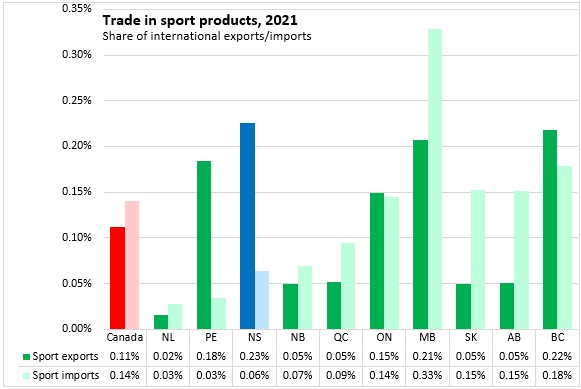The Economics and Statistics Division maintains archives of previous publications for accountability purposes, but makes no updates to keep these documents current with the latest data revisions from Statistics Canada. As a result, information in older documents may not be accurate. Please exercise caution when referring to older documents. For the latest information and historical data, please contact the individual listed to the right.
<--- Return to Archive
For additional information relating to this article, please contact:
October 10, 2023TRADE IN CULTURE AND SPORT 2021 In 2021 Nova Scotia imported $426.89 per capita worth of cultural products (such as art, films, music, crafts and broadcasting) and exported $135.00 per capita.
On average, Canada imported $600.91 per capita worth of cultural products and exported $478.11 per capita.
Imports of culture products were greater than exports for all provinces except British Columbia.
Ontario reported the highest cultural exports and imports per capita (British Columbia reported almost as much cultural exports). Prince Edward Island reported the lowest cultural imports per capita while Newfoundland and Labrador reported the lowest cultural exports per capita (closely followed by Prince Edward Island).

Nova Scotia exported $19.98 per capita of sport products in 2021, including professional sports and informal sporting events along with education and training. There was $8.98 per capita in sport imports. Nova Scotia exports and imports of sport products were both below their respective national averages.
Exports of sport products were highest in British Columbia; imports of sport products were highest in Manitoba. Newfoundland had the least amount of sport exports per capita in 2021 while Prince Edward Island had the least amount of sports imports per capita.

Cultural products accounted for 1.52% of Nova Scotia's international exports and 3.04% of Nova Scotia's international imports. Nova Scotia's cultural exports as a share of total exports were lower than the national average while cultural imports as a share of total imports were just above the national average.
British Columbia reported the largest cultural exports as a share of the province's international exports. Manitoba's cultural imports were the largest share of its international imports.

In 2021 Nova Scotia had international sport exports that amounted to 0.23% of total exports - the highest share in Canada. Nova Scotia's imports of sport products amounted to 0.06% of total imports. Manitoba's sports imports were the highest as a share of total imports while Newfoundland and Labrador's were the lowest.

Since 2010, Nova Scotia's exports of cultural products have fallen below imports in every year.

Prior to 2020, Nova Scotia's trade in sport products reflected rising exports and declining imports, narrowing the deficit of trade in sport products until there was a small surplus in 2019. In 2020 both imports and exports of sport products contracted - but the contraction was sharper for imports, leaving Nova Scotia with a trade surplus in sport products in 2020 and 2021.

Nova Scotia's largest cultural and sport exports were: film/video, design and education/training (for sport).
Nova Scotia's largest imports of culture products were in crafts, broadcasting and books. Each of these products reported sizable trade deficits for Nova Scotia.
Film/video, education/training (for sport as well as for culture) and performing arts were the only culture and sport products for which Nova Scotia reported a substantial trade surplus.

Source: Statistics Canada. Table 12-10-0117-01 International trade of culture and sport products, by domain and sub-domain, and trading partner (x 1,000,000) Table 12-10-0116-01 International and inter-provincial trade of culture and sport products, by domain and sub-domain, provinces and territories (x 1,000,000)
<--- Return to Archive